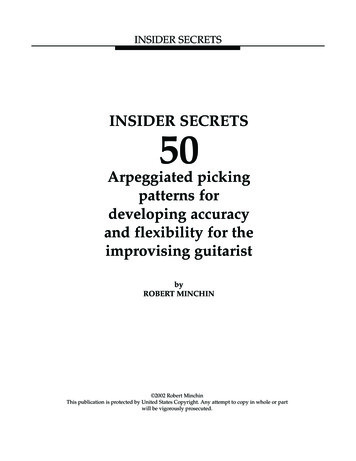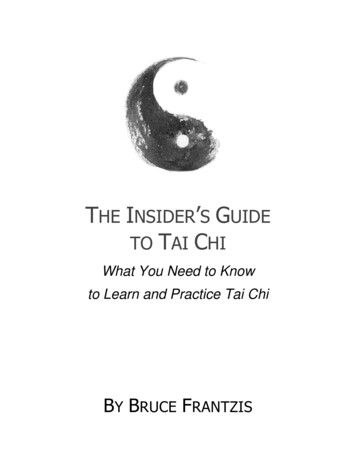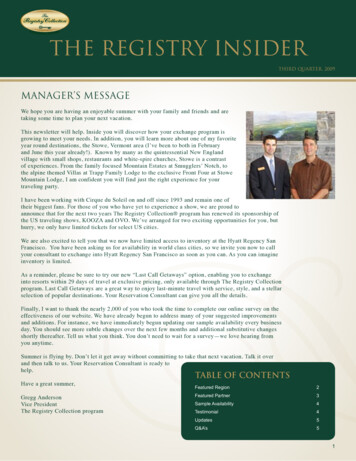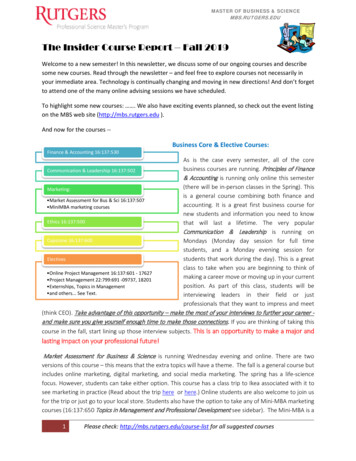
Transcription
INSIDER SECRETSINSIDER SECRETS50Arpeggiated pickingpatterns fordeveloping accuracyand flexibility for theimprovising guitaristbyROBERT MINCHIN 2002 Robert MinchinThis publication is protected by United States Copyright. Any attempt to copy in whole or partwill be vigorously prosecuted.
INSIDER SECRETSThe ideas that follow areprofessional level techniquesand concepts gleaned fromover 35 years of performingjazz and classical guitar andstudying from the masters.
INSIDER SECRETSThe techniques in this volume of INSIDER SECRETS are devoted to developingpicking accuracy for the improvising guitarist.Most guitarists have a great deal of difficulty in skipping strings and changingdirection during a high speed solo. The exercises in this book are designed to help youdevelop the ability to skip strings, change direction and increase accuracy in yourplaying.For years, classical guitarists have used arpeggio studies to develop fluency andvirtuoso technique to cover any type of musical situation that might arise. In classicalguitar, arpeggios are considered very serious study. So they become a critical part ofthe practice session. Classical guitarists also take difficult sections of the music andmake those sections into exercises.For jazz guitarists picking practice has generally been limited to scales. This is anecessary part of study. However, just practicing scales is very limited. That is whyarpeggio picking exercise are so important. It adds another dimension to your arsenalof techniques.This book applies the principles found in classical studies and applies it to plectrumtechnique. It employs arpeggios in the development of these issues.3
INSIDER SECRETSP RO C E D U R EMethod 1. The exercises are written in tablature so that anyone can use them.They are indicated on open strings. Method 1, would be to simply practice using onlythe picking hand, striking the open strings of the guitar. This is a great way to practiceif you find your fingering hand is overly tired from too much practice. In addition, italso allows you to focus 100% of your attention on your picking hand.Method 2. This method uses a chord form that would move up fret by fret as youcomplete a specific arpeggio pattern. I generally use a diminished chord because itdoesn’t tire the fingering hand as much. But you are free to choose any chord form. Tobegin, play a diminished chord as shown:Finger as shown keeping the 1stOOand 6th strings open for the entireFirst fret1exercise. Try to keep the 6th and 1ststrings ringing cleanly and clearly2throughout the exercises. This will3help you to improve your fingeringhand technique by forcing you tokeep your fingers arched andaccurately pressed on the frets.44
INSIDER SECRETSPlay any pattern of your choice while you finger this diminished chord. When youhave completed the pattern, move the chord up one fret and play the arpeggiatedpattern again. Continue in this manner up to the 12th fret, then start moving backdown the neck towards the 1st fret as you play the pattern. Do this for each pattern.This will give you a tremendous right hand workout.When you get to the end ofthe pattern, move the chordform up one fret and repeatthe pattern.5
INSIDER SECRETSS o m e words on practicePractice these exercise very slowly. They are much more difficult than the usualpicking exercises guitarists normally do. Focus your attention on eliminatingunnecessary movement from your picking hand. Also, remain relaxed and hold thepick lightly, don’t squeeze the life out of it. The only way to do this is to practiceS-L-O-W-L-Y and concentrate. You are also training your picking hand to learn newmuscular motor movements, which is another reason to practice slowly. Eventually,increase your speed using a metronome so that you can develop your sense of timeand learn to feel the beat.PRACTICES LO WLY6
INSIDER SECRETSAbove all, don’t get discouraged. These are techniques that take time to develop. Weare not striving for speed at first. We are striving for accuracy. But the rewards aregreat. You will find yourself easily skipping strings and your improvised lines willbecome easier to play.My suggestion would be to incorporate these patterns as a warm up for yourpractice session. 15 minutes a day over a period of time will greatly add to yourplaying abilities.After you have practiced these patterns for awhile, you can invent your own patternsto address specific problem areas in your technique. Most of all have fun and create!USE A STRICT DOWN-UP PICKINGSTROKEFOR EACH EXERCISE.After you have mastered the down-upmovement, start utilizing an UP-DOWN stroke.Then practice using all down strokes, then allup strokes, as well as triplets. Be creative anddevelop your own rhythmic patterns.7
INSIDER SECRETS3 STRING PA T T E R N SPractice using each group of three string sets.String set 1: 1st, 2nd,3rd stringsString set 2: 2nd, 3rd, 4th stringsString set 3: 3rd, 4th, 5th stringsString set 4: 4th, 5th, 6th stringsString Set 1String Set 2String Set 3String Set 48
INSIDER SECRETS9
INSIDER SECRETS4 STRING PA T T E R N SPractice using each group of four string sets.String set 1: 1st, 2nd, 3rd, 4th stringsString set 2: 2nd, 3rd, 4th, 5th stringsString set 3: 3rd, 4th, 5th, 6th strings10
INSIDER SECRETS11
INSIDER SECRETS12
INSIDER SECRETS5 STRING PA T T E R N SPractice using each group of five string sets. String set 1: 1st, 2nd, 3rd, 4th, 5th stringsString set 2: 2nd, 3rd, 4th, 5th, 6th strings13
INSIDER SECRETS14
INSIDER SECRETS15
INSIDER SECRETS16
INSIDER SECRETS6 STRING PA T T E R N SPractice using all six strings.17
INSIDER SECRETS18
INSIDER SECRETS19
INSIDER SECRETS20
INSIDER SECRETSTRIPLET PATTERN21
INSIDER SECRETSIf you have tro u ble maintaining a steady picking hand playing these exercises,there are two ways that I use to keep a firm technique. 1) Rest your picking hand wriston the strings and pivot your stroke from the wrist. And 2), simply place fingers onthe pickguard to steady the hand as you pick. I find the first method far superior.Eventually, you will develop enough skill to make your picking hand independent ofsupport. Although everyone supports the picking hand in some manner.Also,there are at least 3) types of picking stro kes:1) The first would be to pivot from the wrist as you support your self with thebottom of the wrist resting on the strings. I generally just rest the pinky finger side ofthe bottom of my wrist on the strings, with all the fingers gently curled in (notextended).2) The second method uses a circling technique. This is much like holding a pen andwriting with it. It originates from the movement of the first joint of the thumb andforefinger. This is much smaller physical movement than pivoting from the wrist.And finally 3), would be a combination of the first two methods. You mustexperiment and develop a technique that suits your own physical makeup. Everyoneshands are different and require special attention in order to develop the right pickingstroke for each person.22
INSIDER SECRETSMusical ExamplesThe musical examples on the next few pages represent a very small sampling ofwhat can be done by applying these exercises to the creation of actual musical lines.Wide intervals, arpeggios, skips of all kinds can be accomplished with the techniqueyou will develop from this type of practice.The following examples are not claiming to be great musical ideas. Only ideas thatdemonstrate some of the ways you can apply the techniques in this book.When constructing your solos using wide intervals, string skips, and directionchange, try to always be guided by your ear. Afterall, music is an “ear” art.Just because one has developed extraordinary skill, does not mean they should notbe guided by good taste.It does not matter what style of music you play, the skills derived from this book willhelp anyone become a better technician.23
INSIDER SECRETSETC.ETC.ETC.24
INSIDER SECRETSETC.ETC.ETC.25
INSIDER SECRETSETC.ETC.Bbmaj7ETC.26
INSIDER SECRETSAs mentioned before, these are based on classical guitararpeggio studies. If you listen to classical guitar, and Ihighly recommend that you do, you will hear thesetypes of arpeggios. And, in fact, if you play fingerstylejazz guitar, these exercises will open up new avenues ofplaying mechanisms for you to incorporate into yourchord melody arrangements.Be creative and most of all, have fun!27
INSIDER SECRETSFinal W ordsI have been playing for over 35 years and still findthese exercises quite challenging. I use them as awarm-up or while watching TV. And after 15 or 20minutes my picking hand is generally tired, just likeafter a good workout. So my advice is not to killyourself with these exercises. Take it nice and easy.You will find that after some time your pickingtechnique will have improved tremendously. But, yes,it does take time. If you practice on a schedule andkeep it up, you will be amazed at how fast yourtechnique can improve.28
jazz guitar, these exercises will open up new avenues of playing mechanisms for you to incorporate into your chord melody arrangements. Be creative and most of all, have fun! 28 INSIDER SECRETS Final W ords I have been playing for over 35 years and still find these exercises quite challenging. I use them as a warm-up or while watching TV. And after 15 or 20 minutes my picking hand is generally .











